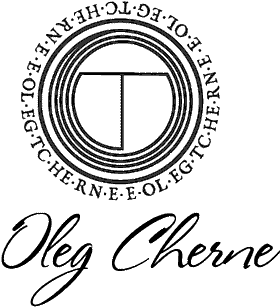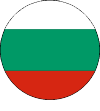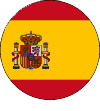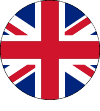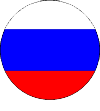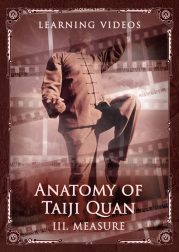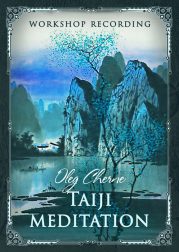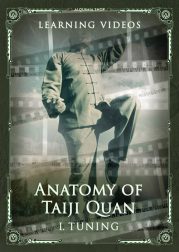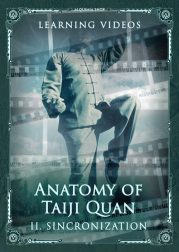Jin Gang Dao Dui
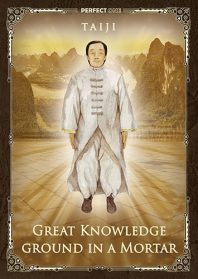
Jin Gang Dao Dui (金刚捣碓) is a Taijiquan movement form, which translates to “Great Knowledge Is Pounded in a Mortar,” or “Diamond Power Is Pounded in a Mortar.” This form is also called “Center Protection Form” or “Buddha’s Warrior Attendant Pounds Mortar.” The movement embodies the support and escape from disorder that fills you with inner strength.
This is the first movement of thirteen conditions that make up the art of comprehending one’s own form, where the Yin–Yang ratio seeks support in Wújí (literally, Without Ultimate). The Jin Gang Dao Dui form contains the concepts of depth, location, and proportion. This is the first of the Thirteen Taijiquan forms and the first condition in building body geometry where we can find the five paths of force (the winding silk thread) and collecting strength in the center (pounding the mortar).
The name of this form consists of two parts: Jin Gang literally means inner strength, which represents both adamancy and poignance (another interpretation is 金刚—King Kong). This name has sacred meaning in the form of a spell, enclosing energy inside, resembling something majestic and fulfilling.
The meaning behind holding the magic staff is to pound grain in a mortar. In this form, the right hand is clenched into a fist, playing the role of a heavy staff, and the left hand with the palm facing upward forms a bowl, representing a mortar. The leg and arm move together to support the inner (mortar, tripod), which forms the area embodying the lower cinnabar field.
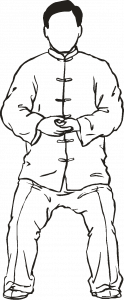
This posture represents the connection of Jing essence and Shen spirit, the upper and lower parts of the body, the four corners and four cardinal directions, all bending and stretching through endless changes and transformations that emanate from the raw and unchangeable—pure nothing.
The Taijiquan practice was originally viewed as the art of comprehending depth, which has its own inner orientation toward unlimited or deep development. According to Daoist alchemy, the art’s power comes from the northern sector of the sky where one finds Ursa Major, the ladle of which accumulates the vital forces of the sky (the nature of Shen energy).
This power is a natural secret in the human body, called Zhong Qi; it refers to the concept of mental power and the real meaning of internal energy. Simply put, our consciousness must turn northward.
Great or limitless knowledge starts from strengthening the spirit, which comes with harmonization and focus of physical consciousness (straightening the head) and attunes with the consciousness of your spirit (Jade Pagoda). It’s important to concentrate the spirit of the entire body in the lower part of the body, but from the very beginning it’s important to understand the Gèn Trigram, the concentration of inner strength—Shen (in the area of the crown of the head [Ding Jin], whose position grows especially important in higher forms—11, 12, and 13). All of this also applies to concentration, which must be available to the entire body—both in a clear and unclear (not yet manifested) expression.
To make sure the energy is returned and not emitted, it’s important not to raise the shoulders and maintain the elbows close to the body. This helps the energy return to the Dantian and kidneys. To do so, we must also keep composure in the mouth to form an internal nutritional environment (produce saliva). Focus your eyes (look straight ahead); do not look to the side. Your eyes’ task is to develop mental strength.
Position of legs
Any movement starts with support; therefore, with the legs. It’s an important aspect in understanding movement—as the legs move, the arms follow, and the body transforms. While moving or holding a static position, it is equally important to perceive your feet, knee flexion, and the perineal region, so the energy can constantly circulate between the lower abdomen and the legs.
Your feet should perceive the direction so that the area of the heel bone (Dazhong) and the big toe (Dadun) can not only regulate energy flow but help organize the movement. They also participate in infusing energy along with the Qiao Yin (fourth toe), Zhi Yin, and Tong Gu points on the little toe.
We can then talk about the cultivation of inner strength, its upward movement, and the ability to connect with the earth, where the implementation of the first principle of constructing the proportion of the body from the position of the earth begins.
Position of the lower body
The lower body organizes the efforts of the legs, directed downward. The space between the legs must be rounded and empty to help maintain circulation in the legs, along with the connection to the hips and the Dantian center. It’s important to prepare yourself for perceiving the lower back’s inner strength. The movement should follow the support to the center. The lower body’s position depends on whether you are starting out (in which case it’s important to find support for the movement) or have experience and are able to use the strength of your lower back (moving the support from Qi to Jin).
Position of the chest
Tighten your chest and stretch out your back. Lift up your chest but ensure that it does not bend inward or bulge out, thereby stretching your spine up and down. Slightly pulling your shoulders inward and immersing the energy in the elixir field along with your consciousness helps determine the right chest position.
Position of the head
Accept the foundational importance of mental strength, focus, open the neck, and support the crown of your head. This will help keep your thoughts in the elixir field (Dantian).
Position of the arms
Arm positioning is the most difficult part in the art of inner work for building body proportions. Our position and movements depend on our arm position, and the arms‘ task is to influence the law of conservation of energy. Your arms must define the connection between the elbow, the shoulder, and hand in order to form the internal movement.
Unlike the legs, the arms engage in external movement. Our arms constantly listen to our body and the work of our legs, keeping the internal force in the hands (in the center of the palms) and forming the internal reeling needed to escape the external Qi. In other words, our arms are two spirals reeling inward from the inside. The Jing effort is behind the reeling thread, forming the inner knowledge of the Supreme Ultimate. Any movement should deviate from the force of direct or reverse thread reeling.
This understanding should manifest itself within the fingers. The spiral must reach your fingertips, and it is crucial to position your arms correctly so the upper body is not rigid or stagnant. The movement of the arms brings the lower body into motion, and the arms must be in alignment with the chest area for the Qi flow to move throughout the body.
Conclusion
The first Jin Gang Dao Dui form describes the understanding of the movement pattern, correspondence, and mortar (tripod) support. It is important to develop the ability to move and change your position according to the movement pattern (diagram). The movement pattern allows you to circulate energy from the left hand and clockwise, supporting it with the right hand, so the consciousness consolidates in the mortar, activates the perineum (Hui Yin center), and moves into the right foot.
The energy is divided into both ascending and descending patterns so the energy accumulated passes through the process of distillation and transformation. If we don’t make an effort to reel the energy along our upper and lower limbs from the very start, we will fail to join the energy into a circle and split it even more.
The key purpose of this form is to find support for the energy flowing from the head to the abdomen, from the perineum to the feet, and from the shoulders to the fingertips. It’s important to grow acquainted with the energy coming in and out of the Dantian center.
The arm’s inner strength derives from the chest and passes through the shoulder and the elbow to the fingers, thus forming the essence of the Jing energy in the arms. The essence of the Jing energy in the legs derives from the abdomen. The essence of body energy comes from the head. But energy generation and energy return are two differing essential aspects. Energy return implies attracting energy rather than a conditional or unconditional run-off.
Energy return must reach the pubic bone (Heng Gu) so the energy can move to the area of the lower cinnabar field (the uterus for women) and kidneys.
The construction of the cinnabar field and promotion of energy to the lower back depends on this form’s effectiveness. But, most importantly, this form allows you to create a channel (Chong Mai) connecting the center of the abdomen and the brain. Building this connection gives us the internal means to control the energy, which is particularly important for the movement in the kidneys, chest, mouth, brain, spine, perineum, knees, and feet.
This affects the overall energy flow and its penetration when the energy moves in a different direction. It’s important to develop the right attitude toward the flow of energy—even if you don’t feel it.
Keep your torso upright; lower your shoulders. Elbows in; fingers and toes pointed; knees bent; perineum open. The movement starts with the left hand, and it feels as if you are constantly spinning a ball. And then the Qi of the upper segment constantly returns to Dantian (which should always be the case), allowing the head to lead and control the Qi movements, like a powerful flow, breaking stagnant positions and movements in each particular stance. It’s important to maintain continuous internal circulation.
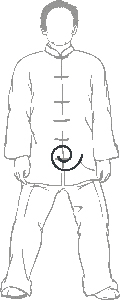
Movement form
- Yu Bei Shi (Preparation)
- Jin Gang Dao Dui (Diamond Power Pounded in a Mortar)
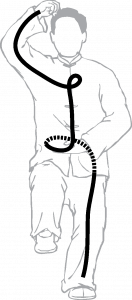
Video
Lecture by Oleg Cherne “Ideology of practices in motion”
Lecture by Oleg Cherne “Taijiquan – lost knowledge”
